The mystery of the tapestry from Bayeux and the Battle of Hastings (Part of 2)
Want to see the tapestry with your own eyes, well, go to the ancient Norman town of Bayeux, which is conveniently located in the valley of the River Orn.
From afar, the medieval cathedral catches the eye, the vague outlines of towers and spiers, which gradually, as they approach the city, become more clear. The road circles around the old center, like a protective fence, within which lies a web of shady streets and ancient stone buildings; here and there, the facades of wooden houses in the style of the late Middle Ages glitter in the sun, as if they had penetrated here, into our present, from the past. In the center of the city stands a huge cathedral, a Gothic masterpiece in the Romanesque style. Its western towers, erected in the time of William the Conqueror, still hover above the small houses at their feet. However, not this cathedral, no doubt outstanding, but still quite ordinary by French standards, attracts half a million tourists to Bayeux every year. They come to see one of the greatest and mysterious works of art.
Signs leading to this masterpiece can be found in the city center everywhere. They have only one word, in English or French “Tapisserie. Tapestry". Here, in Bayeux, the other words are superfluous.
The road, marked with “Gobelin” signs, leads you along narrow streets, under the shadow of ancient houses and the cathedral. She passes by the shops selling all the things that can be decorated with the image of a tapestry from Bayeux, from mugs and waffle towels to rugs for mice and T-shirts. Under the pale green tent of the Le Buillaume restaurant you can take a break and remember the feats of arms of the Duke William of Normandy, or his wife, Queen Matilda, if you stay at the La Reine Mathilde hotel.
Then the path leads you past these institutions along De Mesmono Street to the impressive 17th century building, which was turned into a museum at the beginning of the 1980s.
You open the museum door. Inside is silence and twilight. You buy a ticket. Then go along the wide staircase and, after passing a few doors, step by step, approach the holy of holies of the medieval riddle. Then there will be a long, narrow corridor with no windows and with an unexpected bend in the middle. It is here that there is a tapestry from Bayea, carefully covered under thick glass. He stretches before you like a giant film, a beautiful, colorful frieze from the depths of the Middle Ages. Although this work of art is only half a meter wide, it is incredibly long, especially for such an old work. It seems that if you take the tapestry in hand, it will crumble. Tapestry stretches along the wall, then bends and stretches further. Its entire length is 70 m, but it would be even longer by about 60 m if the final part had not been lost in the deep past. And even in this form, the remaining tapestry can cover the third part of the column of Nelson.
Yes, it is here, in the heart of Normandy, that the dramatic story Norman invasion of England in 1066. Despite its age and fragility, the tapestry is perfectly preserved. Most of what we see today on the tapestry is the original, and those scenes that have been restored have been reproduced with great care and do not change their original interpretation.
The tapestry is made on a simple linen cloth with woolen threads of red, yellow, gray, two shades of green and three shades of blue. Despite its antiquity, it remains so bright and captivating, as if it was finished yesterday, and not a thousand years ago. An extraordinary story unfolds as you walk along a dimly lit gallery. The flaxen scene is quickly filled with figures that are busy with their affairs, who are in castles and halls, on ships and on horses, or are looking intently somewhere. This is a medieval tale of intrigue, danger and war. It begins with mysterious events that took place a year or two before 1066, a critical background for all subsequent actions, culminating in the battle of 1066, the most crucial year in English history.
Interestingly, the greatest drama in history and daily affairs are recorded by the artist without ambition, and as if in a random order. Some people here feast, eat meat on skewers, others drink wine poured into cups of elephant tusks, others hunt, sow or go to church; men cross the river ford, raising their tunics high, load provisions on ships, and then fight. Every time you look at a tapestry, the thought involuntarily arises that new details appear on it that you have not seen before. This work is understandable because it is obvious, but at the same time it is mysterious and tempting. Commentary on Latin, running along the upper boundary of the main frieze, sheds light on the content of the canvas, but enrages because of its brevity and ambiguity. Above and below the main frieze are two narrow borders filled with strange pictures: real and mythical creatures, ancient legends, astrological symbols, scenes from ordinary life, and even individual erotic episodes.
Despite the signature stating that it is a tapestry, in fact it is not a tapestry at all. To be precise, this is embroidery, since the images are embroidered on fabric and not made in the manner characteristic for tapestry making, but this piece is perhaps the most famous “tapestry” in the world, so it would be too pedantic to insist on changing it titles. We do not have wall decorations of this time to compare them with this tapestry from Bayeux, there are no documents describing when, why and by whom it was made. All that we can learn about the tapestry from Bayeux, it is possible to learn only from the historical investigation. For example, the way he appeared in Bayeux, if the first mention of him is dated 1476.
Even after you have seen the tapestry from Bayeux many times, its details, length and complexity of manufacturing still continue to amaze. So, it depicts 626 human figures, 202 horses, 55 dogs, 505 other animals, 49 trees, 37 buildings, 41 ship. The tapestry tells about men: from 626 human figures, only 3 on the main frieze and 2 on the curbs belong to women. In a few intriguing episodes, you can even recognize unnamed characters, but to identify people you usually have to resort to signatures in Latin.
The comment contains only the names of the 15 characters; Obviously, these are the main characters of the tapestry. These heroes mainly belong to the upper echelon of medieval society, and are mentioned in any study of 1066 events. These are Edward the Confessor, the old king of England, and the two main contenders for his throne, Count Harold of Wessex and Duke William of Normandy. However, in addition, 4 unknown figures are mentioned: the dwarf Turoold, the acting groom, the English Lady Elfiva, who has an affair with a priest, and two younger Norman knights - Wadard and Vital. And here we have the first mystery of the tapestry: why the dwarf, an elegant, but scandalous lady and two junior knight-Normans, share fame with kings, dukes, counts, bishops, thus forcing us to find out who they are and what role they played in 1066 events For what they were immortalized on the tapestry? Another important character on the tapestry is Bishop Odo of Bayeux, depicted on it with the baton of a commander in his hands, more like a blunt club. Odo was a greedy and ambitious half-brother Wilhelm and his main supporter in this conquest after which he became one of the richest men in England.
According to the popular concept, the tapestry from Bayeux is a work about the triumph of William the Conqueror. It undoubtedly has great historical significance, but it cannot be taken absolutely straightforwardly. Read any known work, and in it you will find information that the tapestry depicts the story of the childless English king Edward the Confessor, who at the end of his life sent his confidant, Earl Harold on a mission to Normandy. The mission of the count is to inform Cousin Edward, Duke Wilhelm of Normandy, that the old king chose him as his heir. After an accident in another part of France, from which the Duke Wilhelm kindly saved him, Earl Harold duly took him a sworn oath and solemnly vowed to be a vassal of Wilhelm. However, returning to England after the death of Edward in January 1066. Harold himself seized his throne. That is, the Duke William was deceived by a greedy Englishman, and therefore gathered a huge army of Normans and invaded England to lay down his legal rights to the throne. In the end, he, of course, defeats the treacherous Englishman in the battle of Hastings (but not without the support of his stepbrother Odo), and Harold gets an arrow in the eye for his treachery. This story is told "strictly from the point of view of the Normans." This look at the tapestry from Bayeux is repeated again and again in guidebooks, brochures and popular historical books.
But the truth seems to be different from this version, and it is much more interesting. It slowly manifests itself last 50 years in journal articles and, of course, that the general public is completely unfamiliar. Much remains a mystery, and not all experts agree with this version, but there is good reason to believe that the tapestry from Bayeux was not embroidered at all in Normandy, but in conquered England. It is possible that during 10 years after 1066, and that the ingenious artist who created the design for the English sewing team (Queen Matilda had nothing to do with it!), Created a dangerously multilayered masterpiece. There simply existed a romantic tradition, first recorded in the 18th century, according to which the tapestry from Bayeux owes its appearance to the proud and delightful wife of William, Queen Matilde. She and her helpers, as legend has it, embroidered a tapestry to celebrate William’s success in conquering England. By the way, the tablet with the words "Tapestry of Queen Matilda" is still hanging on the wall of the museum in Bayeux, perhaps because a large number of French tourists continue to come to the gate waiting to see the work of Queen Matilda.
In fact, the design of the canvas was just wonderfully thought out and full of secret meaning. Only at first glance the tapestry supports the Norman version. It seems that the idea of the artist was in fact subversive. Working under the leadership of the Normans, he invented embroidery, which, at first glance, should not have disappointed the conquerors. However, with a deeper level of acquaintance with the canvas you begin to understand that he tells a completely different story. At a time when it was impossible to convey the English point of view in writing, the artist did this with the help of drawings. That which could not be said can be shown, covertly and artfully; and the work of art that the Normans accepted and admired was in fact a Trojan horse, in which the English point of view remained. Thus, the story that we are gradually opening today is embroidered in these paintings. According to her, the claims of the Normans to the throne are rejected. And the tapestry from Bayeux looks more like a lost version of the Anglo-Saxon Chronicle.
Without a doubt, the tapestry from Bayeux depicts the victory of the Normans, and their victory itself cannot be denied. We see how a talented artist proceeds to a skillful presentation of the English version of the events that led to the Norman conquest, but even more he tries to assess the conquest from the point of view of the deep religiosity and beliefs of the time. According to the doctrine that prevails in Christianity of the 11th century, all great events took place according to the will of the Lord. Therefore, in search of an explanation of the reasons for the conquest of England by the Normans, the artist turned to the Old Testament and came to the conclusion that the conquest of England was God's punishment for sins. It was just so helpless, conquered people who tried to explain what happened to them; the Normans, for their part, also proclaimed that God was for them. Here everything is intertwined and the meaning of these connections has never been fully and, most likely, and will not be revealed. However, the artist most likely supported Count Eustace II of Bologna, who, although he joined Wilhelm’s invasion of 1066, intended to fight the Normans for power in northern France. Probably, he claimed the English throne. Count Eustace of Bologna is usually mistakenly called the “Norman”, although in fact he was not at all their ardent supporter, and the Duke William did not trust him. There are only three characters on the tapestry: Bishop Odo of Bayeux, Duke William and Count Eustace of Bolon are named among the Normans who participated in the battle of Hastings. At the same time, it is worth looking at the image on the canvas a little more closely, as it becomes clear that of these three, the main role the tapestry assigns to Count Eustace, and not William the Conqueror! That is, a tapestry is nothing but an encrypted monument of those distant events, and if this is true, then its purpose is to tell the truth to the descendants of the defeated British! However, finding it on this tapestry is not so easy.
Tale of consequences
Today, the walls of buildings XI. they look bare and empty, nothing is left of the glitter and luxury of former times. But if we go back in time and enter the limits of the great churches or worldly palaces of that time, we immediately see colorful wall draperies, frescoes and other decorations.
Thus, in the great Anglo-Saxon poem “Beowulf” the hall of a secular building is described as brilliantly decorated with drapes “embroidered with gold”, and “many who were honored to see them cannot restrain a cry of delight.” It is known that the widow of the Anglo-Saxon warrior Bertnoth, who died in 991 in the battle of Maldon, created an interesting embroidery dedicated to the death of her husband, and transferred her work to Eli Church. But she did not survive; we can only guess about its size, design and technique. But the tapestry from Bayeux has been preserved, and even for the XI century. he was an exception, because a very small number of people had enough space to put up a work of that length, and the means to order it. A huge number of jewelry from the fabric, both large and small, has disappeared. So even the fact that at least this one tapestry is preserved, and that is a rare success for historians. It is doubly successful that the only surviving creation of this kind captured the most important event in English history.
In the modern world, it is more honorable to be a conquered people than a nation of victorious warriors. After all, it was said: "Blessed are the meek ...". And although from the eleventh century. England more often acted as a conqueror, the defeat she suffered from the Normans can be considered one of the toughest and most crushing in all of human history. However, the Normans and the French, who landed in England, made up only a small part of the total population of the country (1,5 - 2 million). But they took all the key positions in power. For several years, almost the entire Anglo-Saxon aristocracy was replaced by the French-speaking elite. One by one, the chief bishops and abbots were replaced by the Normans or their appointees. Wealth as trophies of war flowed into the treasury of the conquerors. By 1086, when King William made an inventory of the land in the Book of the Last Judgment, a quarter of England belonged to 11 to his closest supporters. Of the 200 aristocrats who owned the other quarter of the country, only 4 were English. A huge mass of representatives of the Anglo-Saxon ruling class was destroyed in the battle of 1066, turned into second-rate people on their own land or became exiles. The Normans became a new elite, but an important minority was their allies from other parts of France and Flanders. To strengthen their power, the Normans began to build locks, first of wood, then of stone, throughout the country. Before 1066, there were few castles in England. Now fortified castles - square fortresses on man-made hills - have become a characteristic feature of the English counties. With the death of King Harold at the Battle of Hastings, the only person left who could organize opposition in the country. Therefore, the resistance was sporadic and absolutely unsuccessful. And if the fortress took away the hope of a successful uprising, the soul of the people also shrank in the shadow of magnificent churches and cathedrals erected by invaders in the continental style. The elegant, soaring Winchester cathedrals, Eli, are all an outstanding legacy of the Norman conquest, like the Tower - the famous White Tower in London - a reminder of the military force that created it.
In cruel times, all were cruel, but it is impossible not to note the particular cruelty in the character of William the Conqueror. It was she who made the conquest of England possible. He was a man with an iron will. If he believed that he was right, he immediately used all his strength and did not pay attention to innocent victims. The invasion of 1066 was so vividly captured on the tapestry from Bayeux, this is the story of a man's purposeful will to win. Less well known, but no less revealing, is how William suppressed a rebellion in the north of England in the 1069 and 1070 years, where he punished all sectors of society with extreme cruelty. Dividing the army into small detachments, he ordered the land to be destroyed. The warriors burned the harvest, staged a slaughter among the peasants, destroyed the tools of labor.
It was a policy of deliberate terror: for a whole generation the earth did not give birth, famine began - but the rebellion was suppressed. Thousands died. Samson Durham writes that corpses rot in the streets and in houses, and the survivors were forced to eat horses, dogs, cats, or sell themselves into slavery. All villages from Durham to York were ravaged and abandoned. 50 years later, Oderik Vitalis, already mentioned by us, a monk of Anglo-Norman descent, bitterly recalled "helpless children, young people who had just begun their way, decrepit old people" who died as a result of the punitive operation of Wilhelm in the north. The reputation of a cruel person helped William to impose his rule on England. Few dared to speak out against him, even fewer decided to rebel.
The direct human sacrifices of the Norman conquest are great, but the long-term influence of this invasion is also dramatic, and is still felt. The events of 1066 deeply influenced the further development of British and European history. The country left the ranks of the states of the Scandinavian world and turned to face France. For the following centuries, England was ruled by a French-speaking elite, whose interests, and at least ambitions, lay on both sides of the English Channel. Over time, England was increasingly drawn into the regional and dynastic intrigues of France. When, with the death of King Stephen in 1154, the Norman dynasty was interrupted, the French dynasty of Heinrich Plantagenet, the great-grandson of William the Conqueror, took her place. The conflict, known as the Hundred Years War, ended in 1453, is the most prominent example of the long and tangled Anglo-French relations, the cause of which was precisely the victory of William of Normans in the battle of Hastings in 1066.
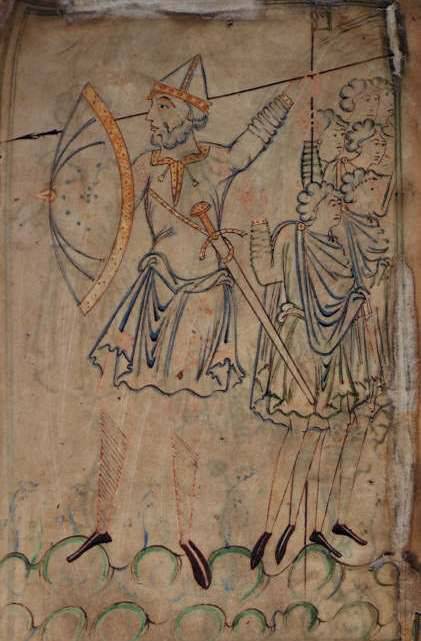
The Anglo-Saxon control system was quite complicated for its time, so the Normans in England kept it. For example, they left Anglo-Saxon counties as an administrative unit. And they persist today in the same borders. Schoolchildren are told that the Normans brought “feudalism” to England, but historians are no longer sure of this, as well as the fact that the term “feudalism” is appropriate for what happened in England. Longer-term cultural and linguistic changes are also easier to define. In an instant, Old English became the language of impotent plebeians, it was almost stopped to write, and the development of English literature, previously represented by Anglo-Saxon poems Beowulf, and The Battle of Maldon, actually just stopped. And if the French laughed at Anglo-Saxon poetry, which seemed clumsy and crude to them, they were able to bring their significant contribution to the new culture. French ethnic poetry, fascinating stories and instructive tales, written for the entertainment of French-speaking lords and ladies in their new English castles, were an important part of French literature itself. Some believe that the first significant work in French - “The Song of Roland” - was written not anywhere, but in conquered England. Be that as it may, the earliest version of The Song of Roland is a copy recorded in England in the twelfth century.
For centuries, two languages existed in parallel: French for the ruling class, English for the middle and lower. As Walter Scott remarked in Ivanhoe, the echo of this social and language barrier is still heard in modern English. Many animals continue to be called the old English terms (sheep - sheep, cow - cow, oh - bull, deer - deer), while dishes made from them, prepared for nobles, received French names (mattock - lamb, beef - beef, beacon - bacon, venison - venison, real - veal). Only in 1362 did French cease to be the language of the English Parliament. When Henry IV entered the throne in 1399, he became the first English king since Harold Goodwinson, whose first language was English, not French. Even in the XVII century. English lawyers used the degenerated form of French in the walls of the court. The Normans never intended to eradicate English. It is said that William the Conqueror tried to learn English, but found it too difficult for himself and gave up. But thanks to the overwhelming majority of English-speaking residents and the constant wars with France, the French gradually disappeared from the colloquial speech, and by the XV century. Modern English has become the main language of the country. By this time, the French language of the Normans and Plantagenets had enriched English with thousands of new words. A huge number of synonyms in modern English appeared as a result of "vaccination" by the French language after the Norman conquest. If Harold had won the battle of Hastings, then the language of modern English would be completely different from the current one.
The construction of the Cathedral in Bayea in 1070, perhaps, was also financed by the wealth confiscated from the English aristocracy. Other traces are less material, but no less significant. Among the fenced pastures of the Cherbourg Peninsula in the west and the expanses of France in the northeast there are many cities and villages, whose names are closely related to some well-known families of Britain. Famous families of British aristocrats - De Quincey, Mobray, Mortimer, Pomeroy, Sackwil, De Vere - happened from places like Quinches, Monbre, Mormemar, La Pomeras, Secuville and Ver. This is also a legacy of the Norman conquest, and all these names still evoke in the ears of the British memories of their clan francophone aristocracy. The ancestors of these aristocrats were influential people who migrated to England immediately after the Norman conquest or with the second and subsequent waves of immigration.
In different ways, the events captured on the tapestry from Bayeux, have influenced English history so that their echoes are still heard. After nine centuries, we can still feel the consequences that cannot be attributed only to conquest, as such. The Norman invasion of 1066 was the last case in the history of England when it was conquered by another state. Neither Philip II of Spain in 1580's, nor Napoleon at the beginning of the 18th century, nor Adolf Hitler in 1940's could repeat the achievement of William the Conqueror anymore ...
So how was it all the same?
It is believed that in the battle of Hastings 14 in October 1066, the equestrian army of the Norman knights unsuccessfully attacked the British while they were hiding behind a “shield wall” on a hill. But, having lured them into an open place by a false retreat, Wilhelm used his advantage in cavalry and defeated the British. King Harold fell in battle, and in England the Norman rule was established. However, why it all happened that way, and not otherwise, English-speaking historians still argue.
At the same time, an increasing number of them are inclined to what actually happened in the battle of Hastings, and what is actually depicted on the tapestry, there is a big difference. Thus, on William’s side, there is only one cavalry, but according to other sources large forces of infantry and archers were involved, and the Norman horsemen were in the rear at the beginning of the battle, and only later were the first to go, although on the tapestry everything is completely wrong ...
Interestingly, in the battle scenes on the Bayesian Tapestry you can see 29 archery warriors. However, 23 of them are depicted on the hem, outside the main field, which clearly indicates their secondary role, although many riders on the main field are literally stuck with arrows. There you can also see four foot Norman warriors (the British themselves prefer the name Normans) in defensive armament and with bows in their hands, and one archer-sax, dressed completely uncomfortable. Equestrian archer is only one. He also does not have defensive weapons and keeps behind the pursuing Saxons of the Norman knights. This is hardly forgetfulness of embroiderers: since all the other details of the weapons are shown on the tapestry in sufficient detail and embroidered very carefully.
From the school history textbook (yes, by the way, the university textbook too!) We know that the main role in this battle was played by the cavalry of the Conqueror, who attacked the Englishmen who stood on the hill several times, who were hiding there behind the “wall of shields” in the end, a mock retreat lured them into the plain. Well, and there, of course, they upset their ranks, and the cavalry immediately surrounded them and destroyed them all. But how could such a thing have happened, because Harold, the leader of the British, was by no means new to military affairs. He literally just won a decisive victory over the Norwegians who landed in England, but for some reason all of his troops are shown on the tapestry on foot, although the shields of his warriors are for the most part no different from the equestrian shields of his Norman opponents!
And Harold himself was at first wounded by an arrow in the eye, and after that he was hacked with the swords of the Norman knights. So here it is the secret tapestry - in front of us! On the battlefield at Hastings that day, it was not the equestrian army of the Duke Wilhelm that triumphed, but the infantry and archers of Count Eustace of Bologna, who literally fell asleep the British with their arrows. It was only at the very end that the knightly cavalry of the Duke William really hit them, but this was unsuccessful! Hardly having overcome the steepness of the ascent to the hill, its riders underwent a fierce Khuskarl counterattack - Harold's elite warriors who skillfully owned their two-handed wide-axes. The Norman knights fled, and panicked rumor spread that Duke William was killed. And none other than Count Eustace, who organized the attack on the British infantry from the flank with a banner in their hands. “There he is, William!” He shouted, and at that time Wilhelm lowered the chain mail visor from his face, threw his helmet back on his head, and the soldiers recognized him.
The soldiers of the Earl Harold, in turn, were not infantrymen, but exactly the same riders as the riders of Wilhelm, with the exception of his famous hozarls, who, however, were not so numerous in his army! But Harold himself, apparently not trusting his warriors and fearing betrayal, ordered them to fight on foot, and hid horses in the nearby forest behind the hill they occupied. After all, it is on horses that they run from the Conqueror's warriors pursuing them after their defeat, which is reflected in the 59 episode of the tapestry.
Yes, and the characters from the fables of Aesop are depicted on the border tapestry is not by chance! They seem to suggest: “Not everything is so simple here! Everything here, like that of Aesop, has a double meaning! ”However, unfortunately, we can only guess at all this so far!
Reconstruction of the course of the battle, taking into account new readings of the Bayesian Canvas
First phase: The British are standing on top of a hill with a long, winding line, hiding behind shields from the front. The Normans step on them from the foot of the hill in three lines. Ahead of the archers, behind them the infantry and, finally, behind it are troops of knightly cavalry, which, of course, could not be very much. On the left flank commanded by the Duke William, on the right - Count Eustace of Bologna.
Maps A.Shepsa
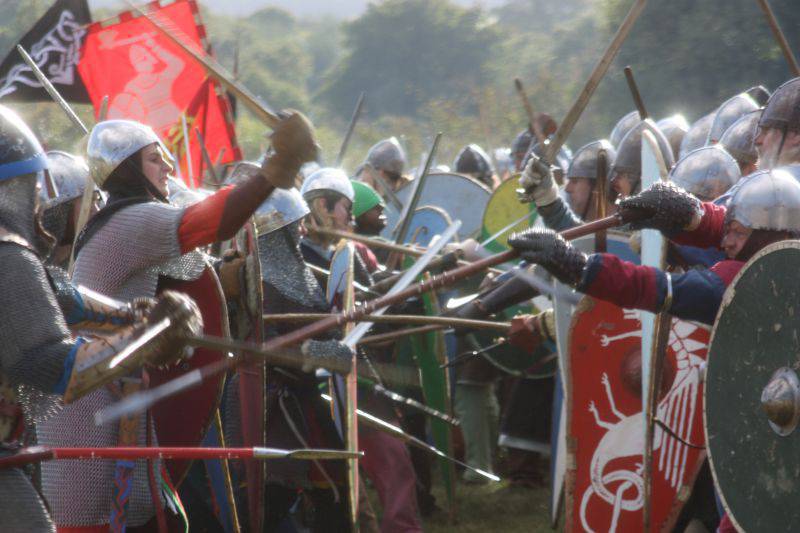
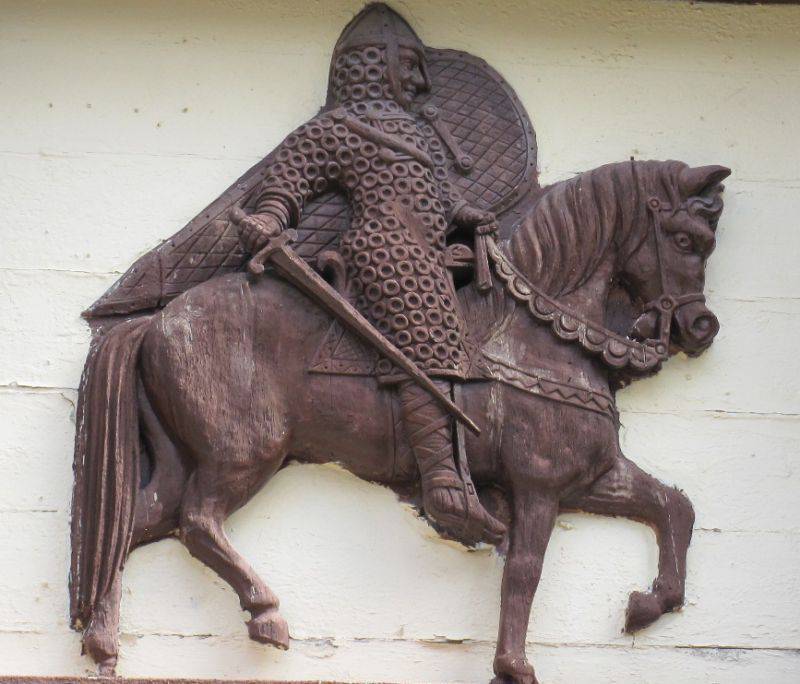
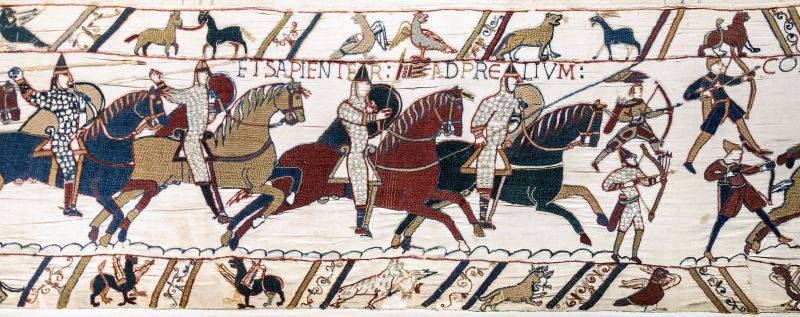
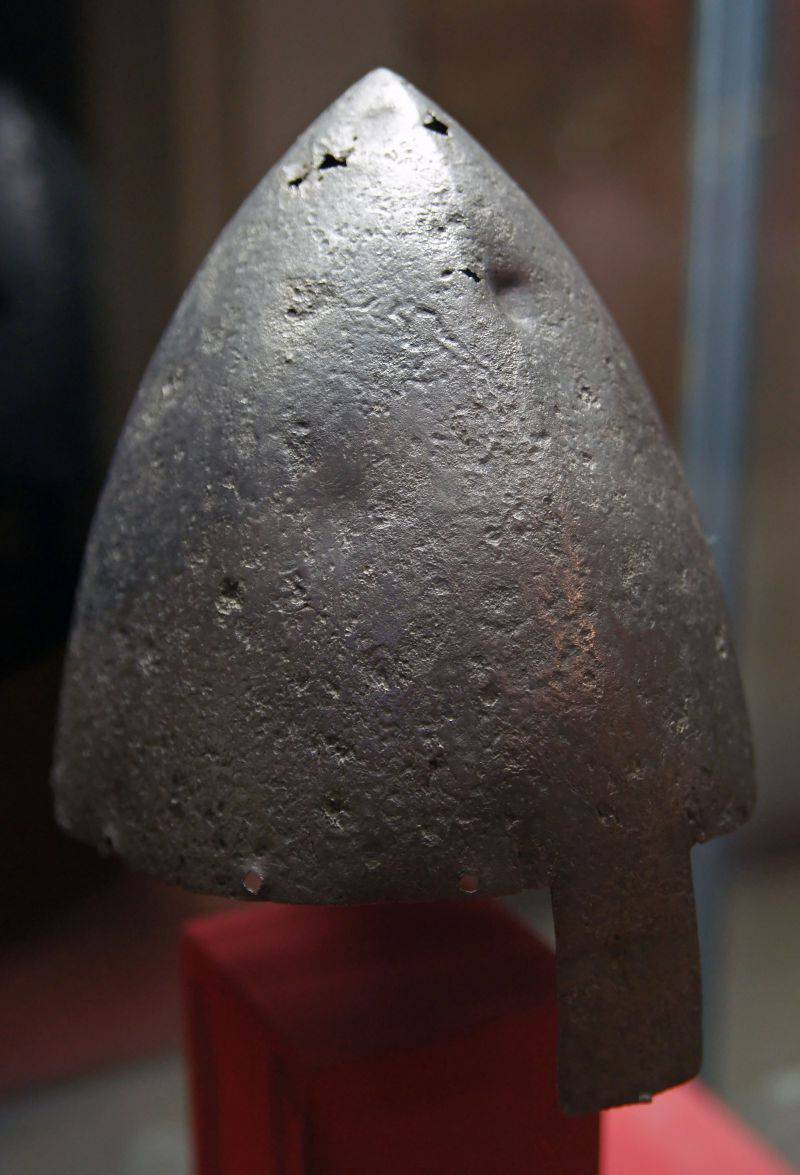
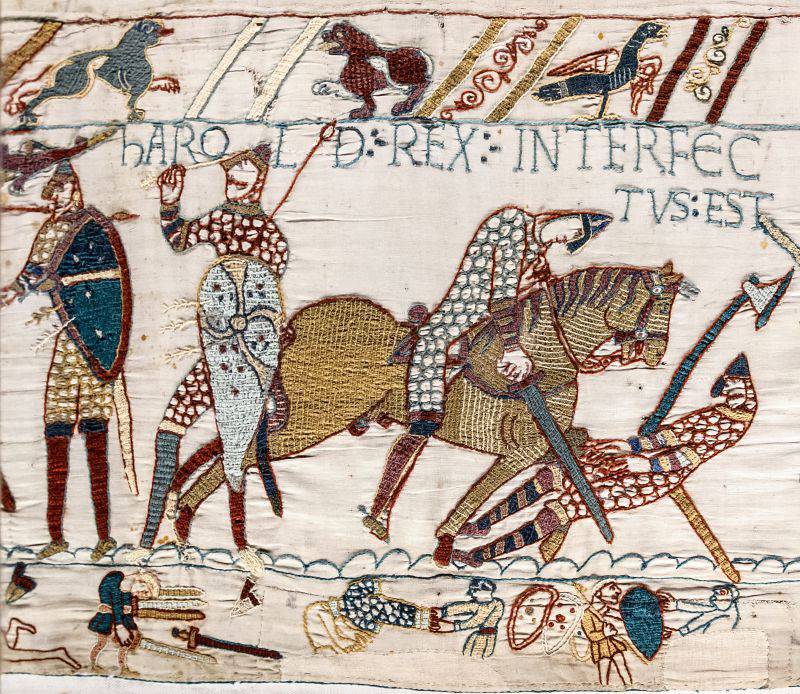
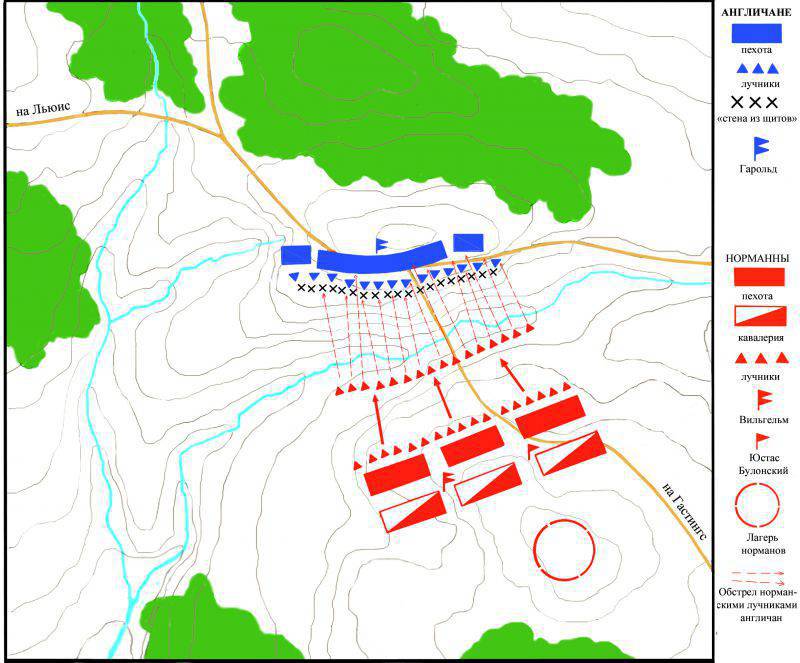
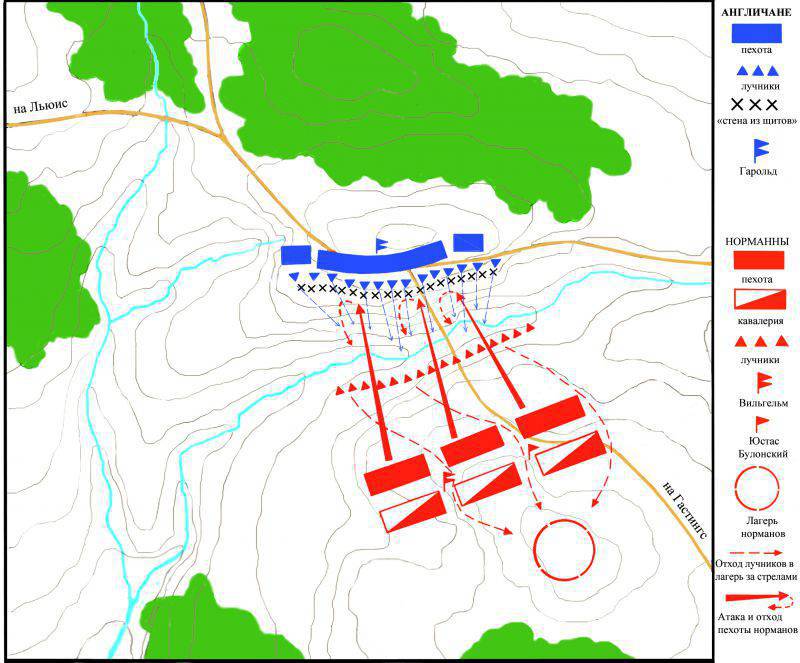
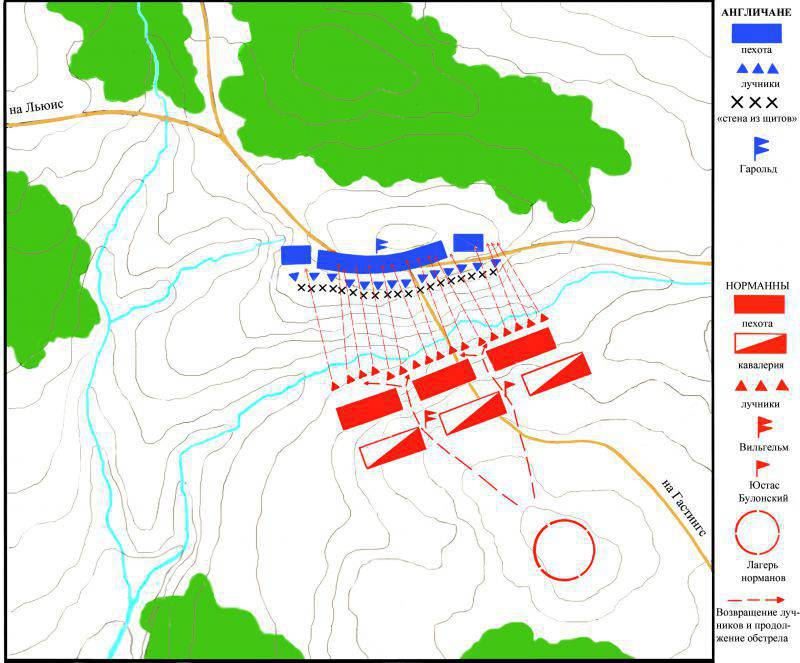
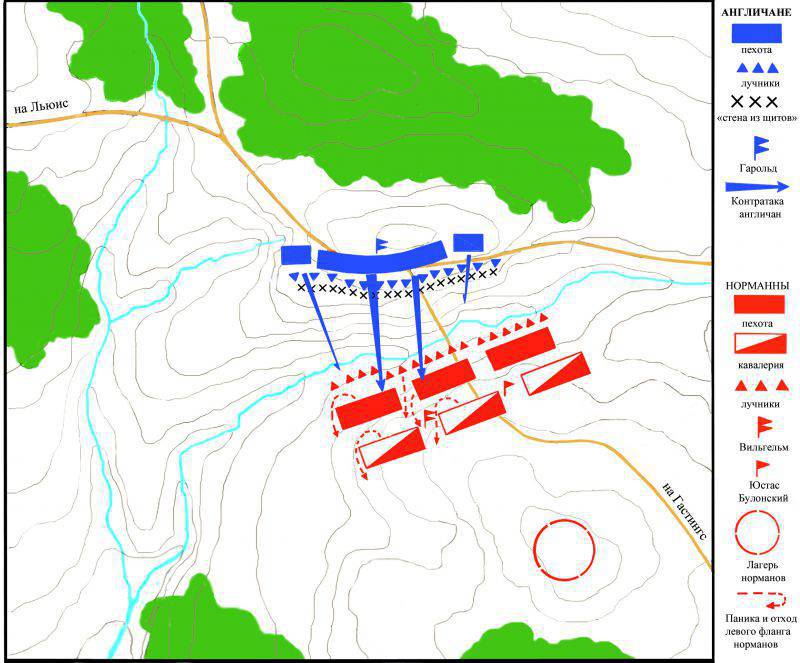
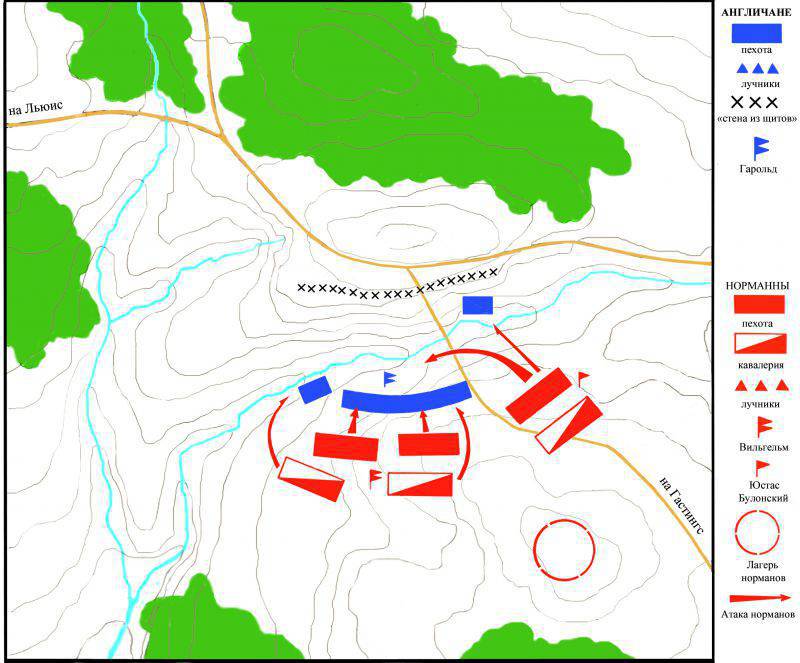
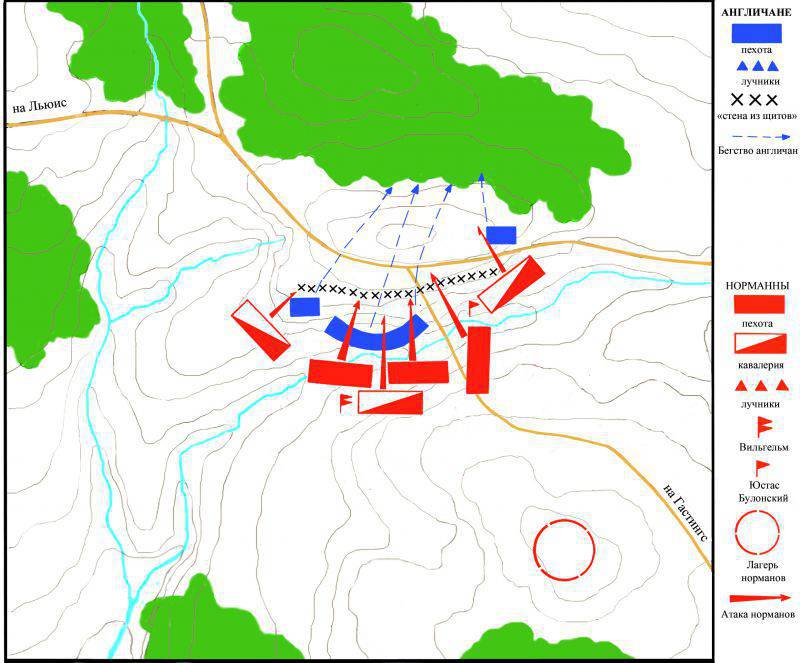
Information